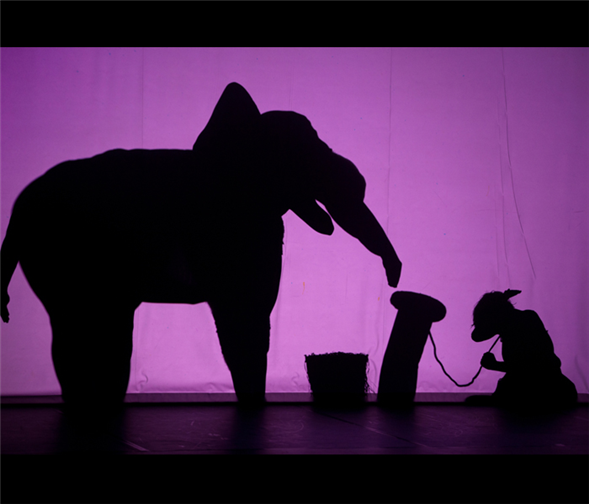Translate Page

Inside their visually astonishing new work
---
Since 1971, Pilobolus has stretched the ways in which dancers share and shift weight in modern dance. The troupe's partnering style—dancers twisting, winding, gently toppling—has continued to remain a trademark. In 2006, however, another Pilobolus stamp was created in an unlikely place: a car commercial. In interlocked positions, the dancers used shadow projections of their bodies to create the shapes of a flame, a seesaw, and finally, a Hyundai Santa Fe.
Since then, Pilobolus' work in the "shadow medium" has exploded, and they've been commissioned by events like The Oscars to produce shadow play that tricks the eye while highlighting dance. Now, the company has created Shadowland, a full-length shadow work in its North American premiere at NYU's Skirball Center from November 20 to December 6.
The show follows the coming-of-age of a young girl through a blend of dance, theatre, and shadow. This allows for a story that moves easily between worlds. In one moment dancers might swoop in front of the screen in realistic vignettes, while in others, we might see a shadow of a dog head floating above a human body.
Still, the company's visceral and collaborative approach to dance remains a highlight of the show. "In Shadowland, the audience is seeing the screen as they would in a movie theatre," says Itamar Kubovy, Pilobolus' executive producer. "But then the feeling of [watching] people lifting, touching, moving each other in this live way calls attention to the human, group participation of the piece."
With this in mind, when the company decided to create the full-length shadow piece, they aimed to integrate it with a worthy story. In that way, the storyline and the choreography— both behind and in front of the screen—were developed simultaneously. "We realized a lot of the shadow choreography is surreal and has all sorts of distortion of size and scale," says Kubovy. "It's sort of scary. So we wanted a story where someone would be affected by those types of weird things that would allow us room to play with perspective, but also keep an emotional journey at the forefront."
Two musicians played key roles in clarifying the narrative. "We reached out to Steven Banks of SpongeBob Squarepants and David Poe, and they both figured prominently in the process," says Kubovy. "David wrote a song cycle and score, and the lyrics present a male narrator voice. We felt it would be interesting to pair 'him' with a young girl as the central character, and a sort of Alice in Wonderland idea emerged. Much of her journey is through her dreams, and it has a lot to do with confronting and overcoming a male authority figure."
{Image1}
As the tale coalesced, so did the shadow work. And even though the team had plenty of experience in the genre, trial and error remained the only reliable creative approach. "People ask me all the time to teach shadow work, but it's simply trying things," Kubovy says. "Pilobolus' style is so much about sharing weight, but in the shadow world, it's a combination of sharing weight and sharing the shadow."
The troupe also realized that the more obvious demarcation of placing a dream world behind the screen and reality in front felt stale. "After three weeks of working with the screen being the division of worlds, we realized the literal boundaries prevented us from telling a fully emotional story," Kubovy says. "We needed a porous relationship between the two. So we freed it up to allow for a spilling out in a way, and for the dancers to move screens. That created a sense of two worlds happening simultaneously."
As per all of Pilobolus' pieces, Shadowland is only finished once the audiences responds. "We're interested to see what the claps, the laughs, the sighing, the focus, and the places where people are distracted are," Kubovy says. "We get it done 75 percent, and the last 25 percent is the audience participation."
This sense of constant discovery is arguably Pilobolus' final, underlying signature. "We always try to land on the line of doing something innovative together with collaboration," says Kubovy. "That ends up being a certain aesthetic, yes, but also an ethic: a way of people working together that's inspiring to audiences. The result feels handmade and human, an accessible kind of magic."
---
TDF Members: At press time, discounted tickets were available to this show. Click here to see all our discounts for dance, theatre, and music.
Lauren Kay writes regularly about dance for TDF Stages
Photos of 'Shadowland' by Emmanuel Donny